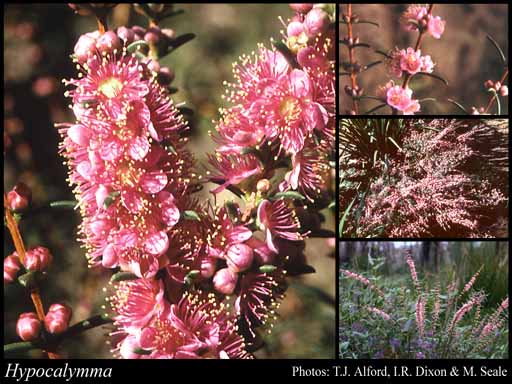- Reference
- Gen.Pl. p1230 (1838)
- Name Status
- Current

Scientific Description
Common name. Myrtles. Family Myrtaceae.
Habit and leaf form. Shrubs; evergreen; bearing essential oils. Plants with neither basal nor terminal concentrations of leaves. Young stems cylindrical, or tetragonal. To 0.3–1.5 m high. Leptocaul. Helophytic to mesophytic. Leaves small to medium-sized; opposite; decussate; ‘herbaceous’, or leathery; sessile; gland-dotted; aromatic; edgewise to the stem, or with ‘normal’ orientation; simple; epulvinate. Leaf blades dorsiventral, or isobilateral, or centric; entire; flat, or solid; terete, or semi-terete, or solid/angular; linear, or lanceolate, or oblong, or ovate; linear, or ovate, or obovate, or elliptic, or triangular; pinnately veined, or parallel-veined, or one-veined; cross-venulate, or without cross-venules. Mature leaf blades adaxially glabrous; abaxially glabrous. Leaves without stipules; without a persistent basal meristem. Leaf anatomy. Hairs absent. Stem anatomy. Secondary thickening developing from a conventional cambial ring.
Reproductive type, pollination. Fertile flowers hermaphrodite. Unisexual flowers absent. Plants hermaphrodite. Entomophilous, or ornithophilous. Pollination mechanism conspicuously specialized, or unspecialized.
Inflorescence and flower features. Flowers solitary, or aggregated in ‘inflorescences’; 1–4 per axil. Inflorescences simple, or compound. The terminal inflorescence unit cymose. Inflorescences in axillary clusters. Flowers shortly pedicellate to sessile; bracteate; (bi) bracteolate; small to medium-sized; regular; 5 merous; cyclic. Free hypanthium present (petals ‘inserted on the calyx’); campanulate. Hypogynous disk present. Perianth with distinct calyx and corolla; 10; 2 -whorled; isomerous. Calyx present; 5; 1 -whorled; polysepalous, or gamosepalous (depending on interpretation). Calyx segments entire. Calyx spreading; imbricate, or valvate; exceeded by the corolla; regular; often persistent. Corolla present; 5; 1 -whorled; polypetalous; imbricate; regular; white, or yellow, or red, or pink; persistent, or deciduous. Androecial members indefinite in number. Androecium 25–80. Androecial members branched. Androecial sequence determinable, or not determinable. Androecial members maturing centripetally; free of the perianth; all equal, or markedly unequal; coherent; 1 - adelphous (connate into a short tube). Stamens 25–80; a similar length to or slightly exceeding the petals; polystemonous; alternisepalous and oppositisepalous; both opposite and alternating with the corolla members; erect in bud, or inflexed in bud. Filaments not geniculate; filiform. Anthers basifixed; non-versatile; dehiscing via longitudinal slits; introrse; cells parallel or slightly divergent; tetrasporangiate; appendaged, or unappendaged. Gynoecium 2–3 carpelled. The pistil 2–3 celled. Gynoecium syncarpous; eu-syncarpous; inferior, or partly inferior. Ovary plurilocular; 2–3 locular. Epigynous disk present, or absent. Gynoecium stylate. Styles 1; simple; attenuate from the ovary, or from a depression at the top of the ovary; apical. Stigmas 1; capitate (or small). Placentation axile. Ovulodes absent. Ovules 1–12 per locule; ascending; non-arillate; anatropous.
Fruit and seed features. Fruit non-fleshy; dehiscent; a capsule (2- or 3-valved). Capsules septicidal, or loculicidal, or denticidal, or circumscissile. Seeds reniform; non-endospermic. Cotyledons 2.
Geography, cytology, number of species. Native of Australia. Endemic to Australia. Australian states and territories: Western Australia. South-West Botanical Province.
Etymology. From the Greek for "under" and "a covering, hood"; said to refer to the cap of the calyx in bud.
Keys
A Key to Western Australian Species in the Chamelaucieae Tribe of Myrtaceae
B.L. Rye, M.D. Barrett, T.D. Macfarlane, N.S. Lander, M.E. Trudgen, N.G. Marchant, K.R. Thiele
Taxonomic Literature
- Wheeler, Judy; Marchant, Neville; Lewington, Margaret; Graham, Lorraine 2002. Flora of the south west, Bunbury, Augusta, Denmark. Volume 2, dicotyledons. Australian Biological Resources Study.. Canberra..
- Marchant, N. G.; Wheeler, J. R.; Rye, B. L.; Bennett, E. M.; Lander, N. S.; Macfarlane, T. D.; Western Australian Herbarium 1987. Flora of the Perth region. Part one. Western Australian Herbarium.. [Perth]..
- Blackall, William E.; Grieve, Brian J. 1980. How to know Western Australian wildflowers : a key to the flora of the extratropical regions of Western Australia. Part IIIA. University of W.A. Press.. [Perth]..